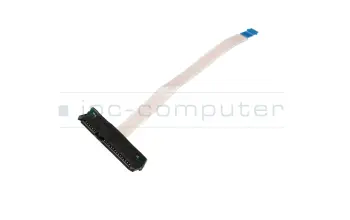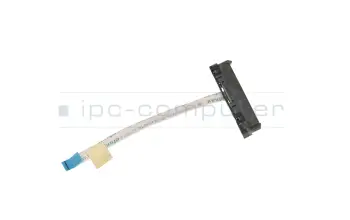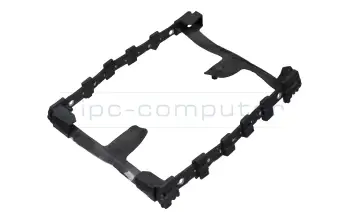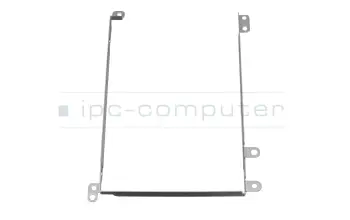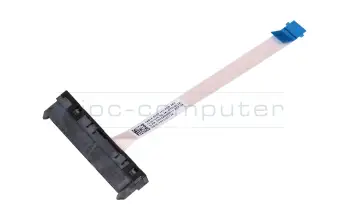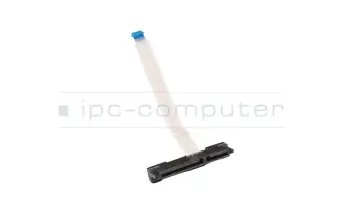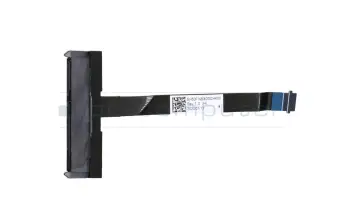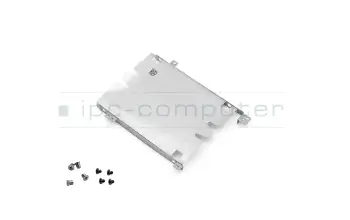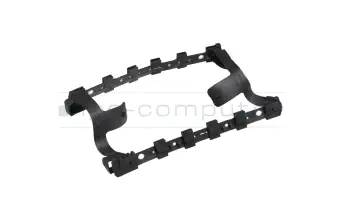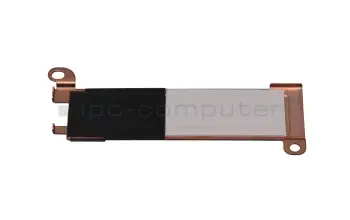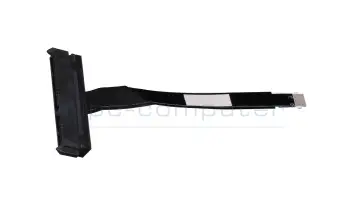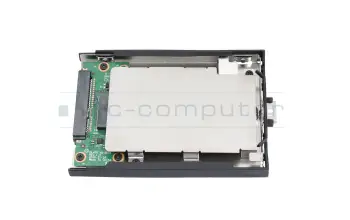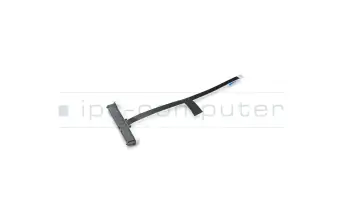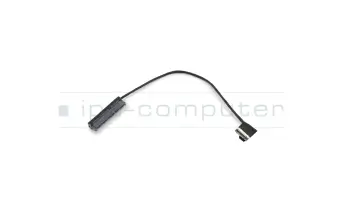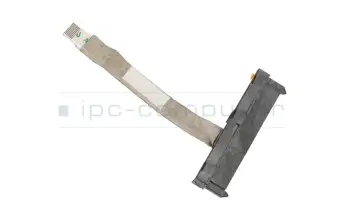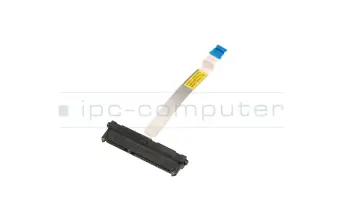Marco de instalación del disco duro y adaptador
¿Qué es un marco de montaje de disco duro?
¿Quieres instalar otro disco duro en tu portátil, pero no hay suficientes ranuras libres? Esto es exactamente para lo que los llamados marcos de instalación de disco duro son adecuados. Se aseguran de que el disco duro no quede suelto en el portátil. En algunos casos, también se requiere un adaptador para conectar el disco duro a la placa principal. Este adaptador también está disponible en nuestra tienda para que coincida con el marco de instalación del disco duro y el modelo de su portátil.
Encontrar los marcos de montaje y adaptadores adecuados por modelo o características
08701-00130000 kit de instalacion del disco duro Asus original para la 2. bahía de disco duro

más gastos de envío
13NB0CB1M09011 accesorio de disco duro Asus original para la 2. bahía de disco duro Kit con tornillos incluidos

más gastos de envío
13NB0IA0L17011 kit de instalacion del disco duro Asus original para la 2. bahía de disco duro

más gastos de envío
13NB0IA0L17111 kit de instalacion del disco duro Asus original para la 2. bahía de disco duro

más gastos de envío
13NB0IA0L17211 kit de instalacion del disco duro Asus original para la 2. bahía de disco duro

más gastos de envío
L52025-001 adaptador de disco duro HP original Incl. el cable de cinta

más gastos de envío
L53743-001 adaptador de disco duro HP original Incl. el cable de cinta

más gastos de envío
NBX0002GX00 adaptador de disco duro HP original Incl. el cable de cinta

más gastos de envío
14010-00212400 adaptador de disco duro Asus original para la 1. bahía de disco duro with flatcable 10 Pin

más gastos de envío
33.GP4N2.002 marco de montaje de disco duro Acer original para la 2. bahía de disco duro

más gastos de envío
50.Q28N2.004 adaptador de disco duro Acer original para la 1. bahía de disco duro

más gastos de envío
33.Q28N2.001 marco de montaje de disco duro Acer original para la 2. bahía de disco duro incl. screws

más gastos de envío
EC20X000500 marco de montaje de disco duro Acer original para la 2. bahía de disco duro incl. screws

más gastos de envío
856614-001 kit de instalacion del disco duro HP original para la 1. bahía de disco duro (M.2 a SSD)

más gastos de envío
5C10R40220 accesorio de disco duro Lenovo original para la 1. bahía de disco duro

más gastos de envío
307-6P10311-HG0 accesorio de disco duro MSI original para la 1. bahía de disco duro

más gastos de envío
13NR00N0AM0301 kit de instalacion del disco duro Asus original para la 2. bahía de disco duro

más gastos de envío
14010-00217800 adaptador de disco duro Asus original para la 1. bahía de disco duro

más gastos de envío
14010-00681000 adaptador de disco duro Asus original para la 2. bahía de disco duro

más gastos de envío
DD0XKJHD000 adaptador de disco duro Asus original para la 2. bahía de disco duro

más gastos de envío
¿Instalar un marco de montaje o un disco duro en un portátil?
La instalación de un marco de instalación de disco duro normalmente no es un gran esfuerzo mientras el portátil tenga una llamada puerta de servicio. Esto tiene que ser atornillado y el marco de montaje, incluyendo el disco duro, puede ser fijado con unos pocos tornillos. Estos tornillos están incluidos en un pedido en IPC-Computadora, así que no tienes que comprar tornillos adecuados primero.
Si tu portátil no tiene una puerta de servicio, las cosas se complican un poco más, porque tienes que desatornillar todo el portátil para instalar el disco duro.
Marco del disco duro del ordenador IPC
El marco del disco duro de la computadora IPC es adecuado para cualquier bahía de unidad SATA, el panel frontal está incluido. La entrega también incluye un destornillador y los dos tornillos para fijar el disco duro en el marco. El modelo está disponible en dos alturas diferentes: 12,7 mm/9,5 mm (Extra Slim).
Con este marco de montaje puedes incluso instalar hasta tres discos duros en tu portátil, dos en las bahías internas y uno en la bahía de unidades. Otra ventaja de la bahía de la unidad es la instalación extremadamente sencilla, por lo que puede reemplazar fácilmente el marco del disco duro por la unidad óptica si es necesario.

Adaptador SATA a USB 3.0 para la serie Asus Vivobook 15 X515MA
El cable adaptador de SATA a USB 3.0 permite conectar un disco duro SATA a través de un puerto USB para SSD y HDD y admite una velocidad de transferencia de datos de hasta 5 Gbps.

Carcasa de disco duro para SSD M.2 SATA para la serie HP Pavilion x360 Convertible 14-dy0000
La carcasa de disco duro plateada para SSD M.2 SATA para HP Pavilion x360 Convertible es compatible con todos los SSD M'2 SATA y tiene un puerto USB 3.1 Tipo-C. El volumen de suministro incluye un cable USB-C, tornillos de montaje y un destornillador. Además, tiene capacidad Plug & Play, por lo que está listo para su uso inmediato.
Carcasa de disco duro USB 3.0 SATA para HP Pavilion x360 Convertible Serie 14-dy0000
La caja de disco duro plateada USB 3.0 SATA para HP Pavilion x360 Convertible, es compatible con todos los discos duros de 2,5 pulgadas y tiene un puerto USB 3.0. Viene con un cable USB, 3 tornillos y un destornillador.
Interessante Beiträge Rund um das Thema Festplatten Einbaurahmen und Adapter
Notebook Festplatten / HDD FAQ
Hier finden Sie alle wichtigen Fragen und Antworten rund ums Thema Notebook Festplatten
- Why doesn't my new hard drive show up in the operating system
New hard drives are often delivered unpartitioned, the user can decide for himself what kind of file system he would like to use. The Windows Explorer will not recognize these and won’t display them. You can take a look at our FAQ “How can I format or partition a hard drive?” to partition and be able to use your new drive.
See also: - What hard-drive tools are there
Our notebook technicians use the following tools for checking the health of disk:
- CrystalDiscInfo (Freeware)
This tool reports all kinds of data concerning the hard drive, like power-on hours and S.M.A.R.T. values.
- HD-Tune Pro (Shareware)
This tool offers a great sector test, whose result is displayed graphically.
If single sectors of a disk are defective, the data can be cloned to another hard drive. Our technicians use the following tools for this:
- Norton Ghost
- Acronis True Image
- Paragon Disc Manager
When installing a Samsung SSD in your notebook you can use their “Magician” Tool to migrate your data to the new SSD. It is included in the delivery of our Samsung SSD's.
- CrystalDiscInfo (Freeware)
- Are the S-ATA standards compatible
Yes, the SATA standards are compatible to each other, however the slowest involved connection type will always be used. This means that connecting a SATA 6Gb/s SSD to a SATA 3Gb/s controller will severely limit its peak performance.
More information can be found in the FAQ “What is the difference between P-ATA (IDE), S-ATA, S-ATA II and S-ATA III?”
- Why is the size of my harddrive that Windows reports less that what the manufacturer advertised
Harddrive manufacturers calculate the size using a base of one thousand. That means that 1 KB = 1000 Byte. However the more common calculation uses a base of 2 to the power of 10 or 1 Kb = 1024 Byte.
This small difference appears when going from Byte to KB, to MB and to GB that is why in the end there is a sizable difference between advertised and usable capacity.
- What is the difference between 512n and 512e
On a hard drive there are so-called sectors. These are the smallest parts than can be read or written to the disk. Traditionally they were 512 Bytes in size. But this allows only so much data to be stored with a given number of sectors. That is why 4 Kilobyte sectors where introduced, these can store eight times the data of 512 Byte sectors. However, not every Operating System and every application were compatible with these larger sectors. This is why manufactures introduced emulated 512 Byte large sectaries (512e). With these the hard drive splits the four Kb sectors into eight 512 Byte sectors, so the OS thinks, that the hard drive has 512 Byte sectors. 512n stand for those drive which have native 512 Byte sectors.
- What is S.M.A.R.T. and what is it for
To increase the reliability of hard drives and the data security hard drive manufacturers have developed the Self-Monitoring Analysis and Reporting Technology (S.M.A.R.T.). it can read important information about the drive like temperature, power-on time and read-/write errors.
- What do I have to look out for with M.2 drives
First thing to consider is the size of the drive. Most M.2 SSDs come in the 2280 form factor. The first two digits indicate the width of the drive in millimeters and the last two, sometimes three digits its length. Other sizes for M.2 cards are 2242, 2260 and 22110, which is sometimes found in servers.
The other difference is in the protocol the drive uses to communicate with the PC. Often less expensive M.2 SSDs still use the SATA protocol, which is also used by drives with more common formfactors. Even though it is rather slow for an SSD, it should still be fast enough for most users. Modern, high-performance M.2 drives use the NVMe protocol which is transmitted via PCI Express. Oftentimes slots, which support PCIe also support SATA, but bevor buying a drive, double check that it is fully compatible.
There are also certain keys, which can give away information about the type of connection used. An SSD with only the M-Key usually uses PCI Express, whereas an SSD with the M- and the B-key usually uses the SATA protocol. The A- and E-key is often used for Wi-Fi cards.

- What hard drive can I install in my Notebook
You have to pay attention, that your hard drive uses the same connection type and form factor or height.
With the very common 2.5” hard drives you have to check whether your notebook still uses the old PATA standard or SATA and also you have to check what height is compatible since there are multiple heights. 7mm, 9mm and 15mm are the most common ones.
For SSDs there are also small form actors like mSATA or M.2. With the latter one you have to check if the slot supports the SATA and/or PCIe (NVMe) protocol.
The only thing that is not limited is the capacity and speed of your new drive.
- What file system should I use
The most used file systems are:
- FAT 16, FAT 32 (Windows 95, 98, ME, XP)
- NTFS (Windows NT, 2000, XP, Vista, 7, 8, 8.1)
- EXT 2 (Linux)
- HFS, HFS+ (Apple Macintosh)
However nowadays most Windows computers use NTFS for their hard drives
The various FAT formats are only used in USB sticks or memory cards.
- How can I make sure my data is safe and prevent data loss
Just like detailed in the FAQ “What is S.M.A.R.T. and what is it for?” S.M.A.R.T. is an industry standard for the constant monitoring of disk parameters like temperature and read- or write errors. With its help errors can be detected before they happen, the data can be backed up and the drive replaced.
However even with careful monitoring the death of a hard drive can always happen unexpectedly. This is why it is very important to back up important data like invoices or family photos to an external hard drive or the cloud. This should be done in regular intervals so that you always have a complete backup of your data.
If your hard drive breaks a data recovery is expensive and time consuming and not always possible.
See also:
The operation in a notebook does not prolong the life of a hard drive. First this is because of the shock and vibrations when moving the device. This can cause the read/write head to crash into the platters in the wort case breaking this head. Move your device carefully while it is on, or even better avoid moving it at all. Secondly, due to the compact formfactor notebooks usually get very warm. That is why putting your device on a notebook cooler can improve the performance and lifespan of your device. Modern solid-state drives are a lot more resilient to shock and heat and therefore more durable, than traditional hard drives. - How can I format or partition a hard drive
You can use the disk management utility built into Windows 10.
- Hit the Windows key and type "Control Panel", then hit enter
- Left click on Administrative Tools
- Select Computer Management and then Disk Management.
- After a short loading time you will be shown all connected drive with their respective partitions.
- Right click on the unformatted drive and click format.
- Follow the wizard to complete the formatting process.



- Wie öffne ich mein Laptop fachgerecht – und worauf muss ich beim SSD Tausch achten?
Das Öffnen eines Laptops erfordert Sorgfalt, das richtige Werkzeug und etwas Erfahrung.
Grundregeln beim Öffnen:
- Gerät vollständig vom Strom trennen und, falls möglich, Akku entfernen bzw. stromlos schalten.
- Geeignetes Feinmechanik‑Werkzeug und ESD‑Schutz verwenden.
- Gehäuseschrauben systematisch lösen und Bodenabdeckung vorsichtig mit einem Kunststoff‑Tool abheben.
- Keine Gewalt anwenden – viele Geräte besitzen versteckte Schrauben unter Gummifüßen oder Aufklebern.
In unserer Reihe „Mein Laptop von innen“ zeigen wir anschaulich, wie verschiedene Notebook‑Modelle aufgebaut sind und welche Schritte nötig sind, um sie sicher zu öffnen.
Die Videos helfen dir, die Bauweise unterschiedlicher Marken (z. B. HP, Lenovo, Dell, Acer) besser zu verstehen und zeigen, wo sich Akku, Mainboard oder RAM befinden.
Wenn du dir beim Öffnen unsicher bist oder fest verbaute Komponenten besitzt, übernehmen unsere Techniker in der Werkstatt den sicheren Ausbau und die Reparatur. - How do I swap a hard drive and what do I have to watch out for
When swapping out your hard drive please also attach the mounting bracket from the old one to the new one. You also have to be extremely careful not to damage any of the plugs and connectors on the mainboard or the drive.

- Where is the difference between HDD, SSD and SSHD
HDDs or hard disk drives are the most common way of storing large amounts of data in a computer. The data is stored on spinning disks coated with a magnetic material, when writing the polarization of a small part of this coating is reversed by the read-write-head. The polarization can be read by the head later on, to retrieve the data stored on the disks. Since the platters are turning, the read-write head often has to wait until the right part of the disks is under it, to read/write data. This makes HDDs a relatively slow storage medium, especially for randomly accessed data. However, through continuously shrinking the individual magnetic parts and increasing the number of platters per drive, a lot of data can be stored on them. In 2017 it was already up to 14TB per drive.
Unlike HDDs, SSDs or solid-state drives have no moving parts. The information is stored with the help of transistor. This means that no time is wasted waiting for the right part of the platter to arrive to read/write to/from it, therefore SSDS are a lot faster. For one of the fastest SSDs on the market the manufacturer claims speeds up to 3,5GB/s, that is more than 16 times as much as a modern HDD. Additionally, SSDs are much more rugged and long-lived due to the lack of moving parts. Unfortunately, they are a lot more expensive per GB than HDDs and the biggest consumer drives are "only" 4TB in size.
SSHDs, which is short for solid state hybrid drives are a combination of HDDs and SSDs. A small SSD, often 8 to 16 GB is used to cache the data for a 1 to 2 TB HDD. In the cache frequently accessed data and data, that has just been written is stored making the drive a lot faster, when accessing this data. However, when accessing infrequently used data or writing a lot of data to the drive, the solid-state cache can no longer be used and performance drops to the level of an HDD.
If you are interested in buying a new drive, our shop has a lot of different types of drives.
- What is the difference between P-ATA (IDE), S-ATA, S-ATA II and S-ATA III
The difference is in the type of connection and its speed.
- P-ATA/IDE (IDE 100/133) Parallel connection with transfer rates of up to 1 Gbit/s or 100 MB/s to 133 MB/s.
- S-ATA (SATA 150) Serial connection with transfer rates of up to 1.5 Gbit/s or 150 MB/s.
- S-ATA II (SATA 300) Serial connection with transfer rates of up to 3.0 Gbit/s or 300 MB/s.
- S-ATA III (SATA Revision 3.0) Serial connection with transfer rates of up to 6.0 Gbit/s or 600 MB/s.


